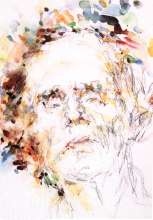VESZELSZKY, Béla
(1905, Budapest - 1977, Budapest)


Painter. He interrupted his studies in pharmacy to enter the Academy of Fine Arts, where he graduated in 1929. He then travelled to Berlin in 1930. Here his attention turned toward the constructivist and expressionist school of art. His view of the world and life, the development of his concept of colour and light in painting were greatly influenced by the philosophy and aesthetics of Jenő Henrik Schmitt and the gnostics. Following his return to Hungary he worked as an art teacher in a number of places in the countryside and in Budapest. Then for a short time he worked as a technical draughtsman and an unskilled hand in a concrete panel factory. His pictures could be seen for the first time publicly in 1962. From that time on he earned his living from his art.
When he was a beginner, from the middle of the thirties up to the middle of World War II, he painted portraits and self-portraits. Most of these were destroyed during the siege of Budapest. He started to paint portraits, still-lifes and landscapes again after a decade of interruption. His abstract compositions reflect the influence mainly of Piet Mondrian, but his unique pointillist paintings are real abstract compositions of his own. His one-artist studio show was organised by Dezső Korniss in 1964. A selection of his works was displayed in Bloomington (USA) in 1972, in Strasbourg in 1974 and in Warsaw in 1966. His commemorative exhibition was held in 1978 and the venue was the King Stephen Museum in Székesfehérvár and the Hatvany Lajos Museum in Hatvan. Many of his paintings are kept in the Janus Pannonius Museum of Pécs, the Balassi Bálint Museum of Esztergom and the Museum of History in Budapest.
